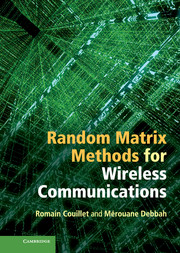Book contents
- Frontmatter
- Contents
- Preface
- Acknowledgments
- Acronyms
- Notation
- 1 Introduction
- Part I Theoretical aspects
- 2 Random matrices
- 3 The Stieltjes transform method
- 4 Free probability theory
- 5 Combinatoric approaches
- 6 Deterministic equivalents
- 7 Spectrum analysis
- 8 Eigen-inference
- 9 Extreme eigenvalues
- 10 Summary and partial conclusions
- Part II Applications to wireless communications
- References
- Index
3 - The Stieltjes transform method
from Part I - Theoretical aspects
Published online by Cambridge University Press: 07 October 2011
- Frontmatter
- Contents
- Preface
- Acknowledgments
- Acronyms
- Notation
- 1 Introduction
- Part I Theoretical aspects
- 2 Random matrices
- 3 The Stieltjes transform method
- 4 Free probability theory
- 5 Combinatoric approaches
- 6 Deterministic equivalents
- 7 Spectrum analysis
- 8 Eigen-inference
- 9 Extreme eigenvalues
- 10 Summary and partial conclusions
- Part II Applications to wireless communications
- References
- Index
Summary
This chapter is the first of three chapters dedicated to providing the reader with an overview of the most important tools used in problems related to large random matrices. These tools will form a strong basis for the reader to be able to appreciate the extensions discussed in the more technical Chapters 6–9. We first visit in this chapter the main results proved via the Stieltjes transform, to be defined subsequently. The Stieltjes transform tool is at first not very intuitive and not as simple as the moment-based methods developed later. For this reason, we start with a step-by-step proof of the Marčenko–Pastur law, Theorem 2.13, for large dimensional matrices with i.i.d. entries, before we can address more elaborate random matrix models with non-independent or not identically distributed entries. We will then introduce the Stieltjes transform related tools that are the R-transform and the S-transform, which bear interesting properties related to moments of the e.s.d. of some random matrix models. These R-transform and the S-transform, along with the free probability theory from which they originate, are the fundamental link between the Stieltjes transform and the moment-based methods. These are discussed thoroughly in Chapters 4–5.
Definitions and overview
To be able to handle the powerful tools that are the Stieltjes transform and moment-based methods, we start with some prior definitions of the Stieltjes transform and other related functionals, which will be often used in the subsequent chapters.
Information
- Type
- Chapter
- Information
- Random Matrix Methods for Wireless Communications , pp. 35 - 70Publisher: Cambridge University PressPrint publication year: 2011
